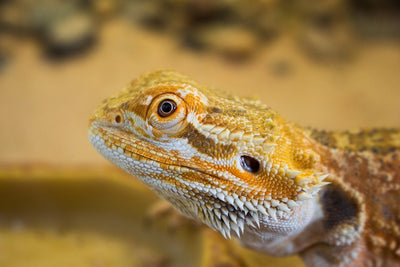Tarantulas are a species of spiders that make fascinating and unique pets. While they may seem intimidating, they’re actually pretty low-maintenance and can be easy to care for with some basic knowledge and a little bit of practice. Whether you’re a first-time tarantula owner or you’ve had one as a pet before, there are some important things you should know about tarantula care to ensure your spider is happy and healthy. In this blog post, we’ll cover everything you need to know about caring for a tarantula, from setting up their enclosure to feeding and handling them.
Tarantula Housing and Enclosure Set-Up
As a general rule, a beginner tarantula keeper should aim for an enclosure size of at least three times the leg span of the tarantula. Although some tarantulas may seem small when you first acquire them, they can grow surprisingly quickly and may require larger enclosures as they mature. It's also important to choose an enclosure with proper ventilation, a secure lid or cover, and escape-proof design to prevent your tarantula from escaping.
The substrate is the bottom layer of the enclosure and is crucial for a healthy environment. Your tarantula needs a place to burrow, so the substrate should be deep enough to allow them to do so, while still remaining firm and supportive. The most popular substrate options include eco-earth, vermiculite, and coconut fiber. Always ensure that the substrate is moist but not overly wet, as excess moisture can lead to mold growth.
Like all creatures, tarantulas need a sense of security and privacy in their habitat. Adding fake plants, hides, or even pieces of cork bark can provide your tarantula with plenty of hiding spots and climbing opportunities. Natural elements such as branches or twigs can also be added to the enclosure to give your tarantula a more natural and authentic environment.
Tarantulas Feeding and Diet
The first thing to understand about tarantula feeding and diet is that these creatures are carnivorous, and in the wild, they primarily feed on insects, small mammals, and even other tarantulas. In captivity, it's important to offer a diet that replicates their natural food sources as closely as possible. The best food options for tarantulas in captivity are live insects such as crickets, roaches, mealworms, and waxworms. These insects are highly nutritious and provide the protein and energy needed for healthy growth and development.
When feeding your tarantula, it's important to consider the size and stage of development of your tarantula as different species have different feeding habits and requirements. For example, a young tarantula will require smaller prey than an adult tarantula. As a rule of thumb, you should offer your tarantula prey no larger than the length of their body to avoid any digestive issues. Feeding them with bigger prey can also lead to problems with shedding. Overfeeding should also be avoided as this can lead to health problems.
The frequency of feeding your tarantula will depend on factors such as their species, age, size, and activity level. Small or young tarantulas typically need to be fed more often than larger or mature tarantulas. Generally, most tarantulas should be fed once or twice a week, but some species can be fed less often. It's important to monitor your tarantula's feeding habits and adjust the frequency accordingly.
For those who are new to tarantula feeding, it's worth noting that tarantulas can be quite choosy about their diet and some may refuse to eat certain prey items. Some tarantulas may also fast for a few days or even weeks, which is a natural behavior. If your tarantula refuses to eat, don't panic as this is normal for them. You can try offering different prey items or adjusting their feeding regime, but if they continue to refuse food, you should consult with a specialist.
Apart from the diet, it's also important to provide clean water to your tarantula. You should always ensure that your tarantula has access to clean and fresh water. The best way to do this is to provide a shallow and sturdy dish filled with fresh water, which should be changed regularly to ensure hygiene.
Tarantulas Temperature and Humidity Control
Tarantulas are cold-blooded creatures that require a specific temperature range to thrive. The ideal temperature range for most tarantulas is around 75-85°F (24-29°C). It is important to note that different species have different temperature requirements, so it is essential to research your specific tarantula's needs. To achieve the desired temperature range, you can use a heat mat or a heat lamp. Be sure to keep a thermometer in your tarantula's enclosure to monitor the temperature constantly.
Tarantulas are also sensitive to humidity levels inside their enclosure. Improper humidity levels can cause a range of health issues, including respiratory problems and dehydration. The ideal humidity range for most tarantulas is around 70-80%. Again, different species require different humidity levels, so be sure to research your specific tarantula's needs. To maintain the desired humidity range, you can use a humidifier or mist your tarantula's enclosure regularly.
Maintaining an appropriate temperature and humidity level for your tarantula can be challenging, especially if you are new to tarantula keeping. Here are a few tips to help you maintain the perfect environment for your pet:
- Place the enclosure in a room with a stable temperature to avoid fluctuations.
- Use a hygrometer to measure the humidity level.
- Cover the top of the enclosure to keep the humidity inside.
- Use a substrate that holds moisture well, like coconut fiber or sphagnum moss.
- Don't place your tarantula's enclosure in direct sunlight or near a heater or air conditioner.
- Use a timer to control the light cycle and simulate day and night.
Proper temperature and humidity control is essential for a happy and healthy tarantula. Providing your pet with the right conditions can help them thrive and live a long life. Maintaining the appropriate temperature and humidity levels can also help prevent health issues and keep your tarantula stress-free. A happy and healthy tarantula is a fascinating and enjoyable pet to have and can bring joy to your life.
Tarantulas Handling and Care
Handling tarantulas can be tricky, and should only be done by experienced and confident handlers. It's important to understand that even the most docile tarantula can bite and cause harm, so proper handling technique is crucial. First, make sure that you are calm and relaxed, as tarantulas can sense fear and become agitated. Always handle by gently picking up the tarantula from underneath and avoid grabbing them from above as this can make them feel vulnerable.
Tarantulas Maintenance and Health Care
Finally, regular maintenance is essential in caring for your tarantula. Check their enclosure regularly for any damage or signs of wear and tear, and remove any uneaten food. A clean water dish and frequent cleaning of their area can also help to keep your tarantula happy and healthy. Regular health checks are important for all pets, and it’s no different for tarantulas. Keep an eye out for signs of illness, such as lethargy, loss of appetite, or a wobbly gait, and seek veterinary advice if you’re concerned.
Tarantulas are unique and fascinating pets that can make a great addition to the right household. However, it’s important to understand the responsibilities that come with caring for one, from setting up their enclosure to feeding and handling them. With regular maintenance and the right care, your tarantula can live a long and happy life.






